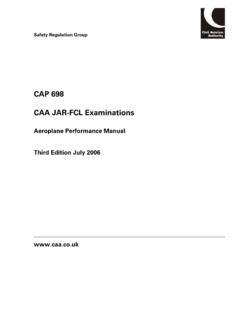Transcription of Operating Resilience of the UK’s aviation
1 Strategy and Policy Department Operating Resilience of the UK s aviation infrastructure and the consumer interest CAP 1515 CAP 1515 Contents July 2017 Page 2 Published by the Civil aviation Authority, 2017 Civil aviation Authority, aviation House, Gatwick Airport South, West Sussex, RH6 0YR. You can copy and use this text but please ensure you always use the most up to date version and use it in context so as not to be misleading, and credit the CAA. First published July 2017 Enquiries regarding the content of this publication should be addressed to: The latest version of this document is available in electronic format at , where you may also register for e-mail notification of amendments. CAP 1515 Contents July 2017 Page 3 Contents Contents .. 3 Executive summary .. 5 Introduction .. 5 Delay .. 5 CAA research .. 8 Capacity Planning and Scheduling .. 11 Operational Consistency .. 12 Conclusions .. 13 Chapter 1 .. 15 Introduction and document structure .. 15 Introduction.
2 15 Structure of this document .. 21 Chapter 2 .. 22 Delay .. 22 Types of delay .. 22 Capacity and delay relationships .. 26 International comparators .. 28 Passenger Interest .. 30 Chapter 3 .. 33 CAA research .. 33 Consumer Research .. 34 Overview of CAA s request for information .. 37 Responses .. 38 Conclusion .. 45 CAP 1515 Contents July 2017 Page 4 Independent Gatwick Delay Causation Study .. 46 Research conclusions .. 47 Chapter 4 .. 49 Capacity Planning and Scheduling .. 49 How an airport declares capacity .. 49 History of increases in capacity and utilisation .. 54 Industry Incentives .. 56 Comparison to passenger interest .. 57 Incentive risk .. 59 Planning and scheduling risk .. 62 Airspace risk .. 66 Chapter 5 .. 71 Operational consistency .. 71 Operational risk .. 71 Options to address risks to consumers .. 72 Information risk .. 76 Chapter 6 .. 78 Conclusions .. 78 The current 78 Options for change .. 79 Appendix A .. 81 Request for Information responses .. 81 Appendix B.
3 88 Glossary .. 88 CAP 1515 Executive summary July 2017 Page 5 Executive summary Introduction 1. The UK s airport and airspace capacity is constrained, and there will be no new significant airport runway capacity until 2025. Our busiest airports are regularly among the worst performing in Europe in terms of on-time performance. Increases in capacity, such as those which arise from higher utilisation of airports, bring more choice and competition, but passengers may also suffer if that leads to more delays and worse reliability. 2. Existing airport and airspace infrastructure will be under increasing demands in the future. In 2016, NATS were predicting1 a further 9% increase in aircraft movements at the five major London airports by 2022. 3. This report examines the current balance of delay and punctuality2 against the number of flights at the airports in the South East of the UK where congestion in airspace and at airports is greatest, particularly in the planning and operational processes that the industry undertakes, and comments on how it reflects the consumer interest.
4 Delay 4. Passengers can be affected by different types of delay even if their flight is considered to be on-time. For example, passenger waiting and queue times may exceed expectations (irrespective of ultimate time of arrival) at security, the gate, on the aircraft waiting to take-off, holding in the air, baggage reclaim or at immigration. However, in this study we generally take delay to refer to 1 2 Delay generally refers to the average number of minutes after its scheduled time that a flight arrives or departs, whereas punctuality generally refers to the proportion of flights that are within a certain delay threshold, usually early to 15 minutes late. Such flights are generally referred to as on time and so on-time performance has the same meaning as punctuality. CAP 1515 Executive summary July 2017 Page 6 on/off stand delay ( the delay compared to the purchased ticket times) of which other delays may be a contributing factor.
5 5. A lack of capacity (both infrastructure and resources), variability and prolonged high utilisation can lead to increasing delays, reduced on-time performance (which is the proportion of flights considered to be no more than 15 minutes later than their scheduled on/off stand time) and difficulties in recovery. 6. At the UK s busiest airports, on-time performance has generally been decreasing and delays have been increasing in recent years, as shown in Figure 1. Although UK airports are not the worst performing in the world3, there is room for improvement. Figure 1: On-time Performance, 2012 2016 Source: CAA Statistics 3 The effects of airport and airspace capacity constraints are evident in other countries such as US and China. CAP 1515 Executive summary July 2017 Page 7 7. As Figure 2 shows, the decline in on-time performance has happened alongside an increase in runway utilisation for UK airports, some of which are constrained by the capacity of their runways4.
6 Figure 2: Annual Runway Capacity Utilisation 2012-20165 Source: ATM capacity: Airports Commission. Actual ATMs: CAA statistics. 8. In the peak summer months, many airports experience even higher utilisation; for example, Gatwick and Manchester handled over 20% more flights in August 2016 compared to an average month. During peak periods, on-time performance is often significantly lower; for example, in 2015 Gatwick achieved during August compared to for year overall, whilst Manchester achieved compared to 9. Airlines, airports and air traffic control are continually improving their processes to reduce delay and improve Resilience . However, the overall effect of these efforts, particularly in the South East, has often been to 4 Heathrow has a limit set by the Terminal 5 planning inquiry of 480,000 aircraft movements per annum, but other airports are typically only limited by the number of flights they believe their runways and other infrastructure can cope with.
7 The annual movement capacities used in Figure 2 are those assumed by the Airports Commission for its traffic forecasting. 5 Airports Commission 2011 base line airport capacity assumptions. CAP 1515 Executive summary July 2017 Page 8 increase the number of services offered alongside an overall decline in on-time performance. 10. As airports approach capacity, it appears that the industry is faced with a trade-off on behalf of passengers between more choice, frequency or competition against less uncertainty, fewer delays and cancellations or higher costs. There are many factors which affect delay, some of which are outside the control of airports and airlines (for example, weather effects and issues in air traffic control from around Europe). Whilst some issues are outside the control of industry, there is a need anticipate issues and create Resilience in operations to deal with these events. CAA research 11. The CAA has undertaken three pieces of research which have informed our conclusions including investigating consumer attitudes to disruption, a consultation request for information and a study into delay causes at Gatwick Airport.
8 12. The CAA commissioned a piece of qualitative consumer research6 to update and expand its existing evidence in order to provide a particular focus on consumers views on day-to-day journey disruption, as well as the effectiveness of operational planning and specific intelligence on consumers using four London airports: Heathrow, Gatwick, Stansted and Luton. The research indicated that: Consumers generally considered the current situation acceptable in terms of the delays they experience, although they would be concerned if those delays were likely to increase. On the whole, they prioritised cost and convenience over delays, and would be unwilling to trade-off extra flights for better performance. This may be driven through a lack of certainty that delays would actually be avoided even if a cost/convenience price were paid. Increasing scheduled block times would just hide delay and they would still be experienced queuing on a taxiway. 6 CAP1472 Consumer attitudes to journey disruption: A qualitative research report CAP 1515 Executive summary July 2017 Page 9 They would be willing to consider (slightly) increased fares if that increased the resources ( ground handlers) used to combat delays.
9 Consumers value greater information provision when they are experiencing delays. 13. In June 2016 the CAA published CAP1420, Operating Resilience of the UK s aviation infrastructure: A request for information 7. We explored two key areas from a UK perspective, recognising that the issues are likely to be more severe in the South East of England. How can the performance of the aviation network be improved or optimised? How effective is the current regime, and how are consumer interests represented? 14. The main relevant issues raised by stakeholders were: The lack of airspace capacity and need for modernisation, both in Europe and the UK. The need for better collaboration / co-operation, particularly where resources runway capacity, ground handling capability, airspace, etc were in short supply. Mixed views about the airport capacity declaration process, with some stakeholders feeling that the UK process led the world whilst others had reservations about whether it prioritised greater utilisation at the expense of worse Resilience .
10 That there were weak links in the aviation system which impacted Resilience , for example, competition between ground handlers. 15. In December 2016, in collaboration with Gatwick airport and the Airport Operators Committee, we commissioned an independent Gatwick Delay Causation study8, which found that: Gatwick is growing but punctuality is reducing 7 8 CAP 1516 Gatwick Airport Delay Root Cause Analysis, April 2017 PA Consulting CAP 1515 Executive summary July 2017 Page 10 With its current infrastructure, Gatwick s runway utilisation is near, and at times exceeds, capacity in recent summer seasons, the holding assumptions used for capacity planning are being regularly reached for arrivals and breached for departures. Short turns9 are very challenging airline schedules are predicated on short turns, but more often than not, these are not achieved. First wave10 performance underpins performance for the remainder of the day there is a strong statistical relationship between the punctuality of the first wave and that of the remainder of the day, maybe unsurprising in an airport where most of the flights are short haul.









